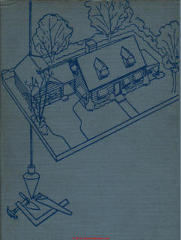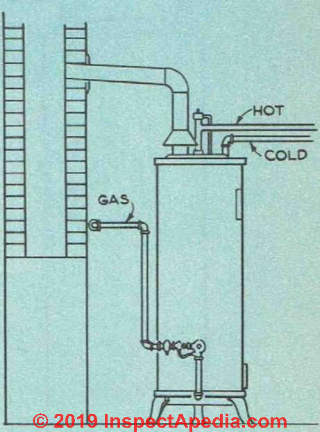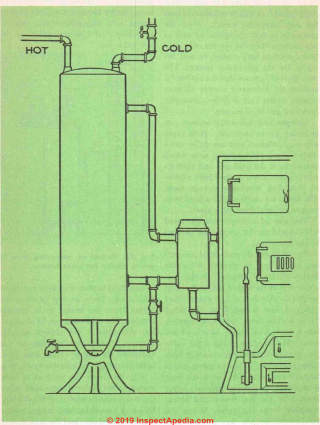 Plumbing for Hot Water Heaters & Storage Tanks
Plumbing for Hot Water Heaters & Storage Tanks
Chapter 13 of How to Build Your Dream Home © 2020 InspectApedia.com
- POST a QUESTION or COMMENT about how to identify the architectural style of buildings and building components
This article series provides an updated version of Hubbard Cobb's Your Dream Home, illustrated by Sigman-Ward, first published by Wm. H. Wise & Co. New York, 1950.
From site selection and obtaining financing through each step in construction of a single family home the simple procedures and drawings in this book are still useful for anyone building or repairing a home or other small structure.
InspectAPedia tolerates no conflicts of interest. We have no relationship with advertisers, products, or services discussed at this website.
- Daniel Friedman, Publisher/Editor/Author - See WHO ARE WE?
Plumbing for Hot Water Heaters & Storage Tanks
 An adequate supply of hot water is a pendent hot-water heater. Of course, “must” in any modern home, and it will
certainly pay to get the very best type of equipment for heating it.
An adequate supply of hot water is a pendent hot-water heater. Of course, “must” in any modern home, and it will
certainly pay to get the very best type of equipment for heating it.
The domestic hot water can be heated by the home's heating boiler or by means of an independent heater (Depending on where you live, synonyms for hot water heater include calorifier, geyser, or hot water cylinder.)
Of course if you use some sort of warm-air heating system, you must have an independent water heater.
Many persons have the the idea that water heated by the boiler (typically by a tankless coil) is not costing them anything. This is not correct by any means.
Additional fuel will be required to heat the hot water in winter, when the system is in full operation, as well as in summer, when the system only goes into operation long enough to heat the water for the plumbing system. The only type of furnace that is suitable for heating the hot-water supply all year around is one that is fully automatic, such as a gas or oil burner.
Details about tankless coils are at TANKLESS COILS - home
This is a section of Chapter 13 of BUILD YOUR DREAM HOME at InspectApedia.com - online encyclopedia of building & environmental inspection, testing, diagnosis, repair, & problem prevention advice.
This entire chapter is also available as PLUMBING SYSTEM INSTALLATION [eBook], or as a PDF image at THE HOUSE PLUMBING SYSTEM [PDF] original page images.
Independent hot-water heaters run on either gas or electricity. Both types are very efficient and are fully automatic. The deciding factor as to which one to use is the local gas and electric-power rates. These heaters have a built-in, insulated, hot-water storage tank. The tanks are made of galvanized iron, copper, or steel lined with glass.
The size of hot water storage tank required will depend on the number of persons in the household.
Fig. 37. Method of connecting lines to gas or electric hot-water heater.
Fig. 37 shows the method of connecting up a gas or electric hot-water heater. A tee is attached to the hot-water line at the top of the heater, and to this is attached a hot-water relief valve.
A line is run from the relief valve to the floor, where it empties into a bucket, or is run outside of the house. The purpose of the relief valve is to prevent the hot-water storage tank from exploding if the pressure inside becomes too great.
The line to the floor (TPR valve discharge tube) is necessary to prevent anyone’s being burned by the hot water and steam escaping from the valve.
[Obsolete: When the local water supply has a very high mineral or lime content, the relief valve should be placed on the cold-water entrance pipe to the heater because it will not become coated with minerals in this location as readily as if it were installed on the hot-water line.] - Current plumbing safety codes require the temperature pressure relief valve to be attached directly to the hot water tank.
An good alternative to tankless coils and often to conventional independent tank-type water heaters are tankless water heaters or "demand" water heaters. These water heating systems use no hot water storage tank but rather heat water as needed, on-demand.
Tankless coils and tankless water heaters are both prone to rapid mineral clogging of the water heating coil in areas where water is high in mineral content ("hard water"). For those installations you will want a suitable water softener installed upstream of the water heater.
Details about tankless water heaters are at TANKLESS WATER HEATERS - home
Water Heater Exhaust Venting
Gas-fired heaters should be equipped with a vent from the top to allow the fumes from the heater to be carried outside. The vent stack can be of metal or other code-approved materials. Newer gas-fired high-efficiency condensing water heating equipment may vent directly outside through a side-wall using plastic exhaust venting and no chimney at all.
Details about direct-vent and side-wall vented heaters are at DIRECT VENTS / SIDE WALL VENTS - home
Fig. 38 shows the method of connecting a hot-water storage tank when the water is to be heated by the furnace boiler. A horizontal tank is used rather than a vertical one, and the tank should be insulated to prevent heat loss.

Fig. 38. Connection of hot-water storage tank to furnace hot-water heater using a side-arm coil to make domestic hot water for washing and bathing.
All types of alternative means of making hot water are given at ALTERNATIVE HOT WATER SOURCES - home
Hot Water Supply
1 30-gallon hot water heater, gas or electric
...
Continue reading at PLUMBING SYSTEM PRESSURE TESTS - next section of this chapter, or go to book contents at BUILD YOUR DREAM HOME, or select a topic from the closely-related articles below, or see the complete ARTICLE INDEX.
Or see these sections of Chapter 13 - PLUMBING SYSTEM INSTALLATION
- PROPER PLUMBING WORK is IMPORTANT
- WATER SUPPLY SOURCES
- TYPES of PIPING MATERIALS
- COPPER PIPE INSTALLATION
- COPPER FLARE CONNECTIONS
- PIPE SIZE SELECTION
- CAST IRON PIPE INSTALLATION
- PLUMBING SYSTEM LAYOUT PLAN
- PLUMBING FIXTURE INSTALLATION BATH KITCHEN
- WATER HEATERS & TANKS
- PLUMBING SYSTEM PRESSURE TESTS
- SEPTIC TANK, DRAINFIELD INSTALLATION
- PLUMBING MATERIALS LIST for the basic house
Or see these
Water Heater Articles
- ALTERNATIVE HOT WATER SOURCES
- ANTI SCALD VALVES & TEMPERATURE CONTROL / MIXING VALVES
- ELECTRIC WATER HEATERS - home
- GAS FIRED WATER HEATERS
- INDIRECT FIRED WATER HEATERS
- OIL FIRED WATER HEATERS
- RELIEF VALVES - TP VALVES
- SOLAR HOT WATER HEATERS
- TANKLESS COILS
- TANKLESS WATER HEATERS - home
- WATER HEATERS - home
- WATER HEATER CLEARANCE DISTANCES
- WATER HEATER PIPING
- WATER HEATER SAFETY
- WATER HEATER TEMPERATURE ADJUSTMENT CONTROLS
- WATER HEATER SIZE SPECIFICATION
- WATER TANK: USES, TROUBLESHOOTING - home
Suggested citation for this web page
WATER HEATERS & TANKS at InspectApedia.com - online encyclopedia of building & environmental inspection, testing, diagnosis, repair, & problem prevention advice.
Or see this
INDEX to RELATED ARTICLES: ARTICLE INDEX to WATER HEATERS
Or use the SEARCH BOX found below to Ask a Question or Search InspectApedia
Or see
INDEX to RELATED ARTICLES: ARTICLE INDEX to PLUMBING SYSTEMS
Or use the SEARCH BOX found below to Ask a Question or Search InspectApedia
Ask a Question or Search InspectApedia
Questions & answers or comments about how to identify the architectural style of buildings and building components
Try the search box just below, or if you prefer, post a question or comment in the Comments box below and we will respond promptly.
Search the InspectApedia website
Note: appearance of your Comment below may be delayed: if your comment contains an image, photograph, web link, or text that looks to the software as if it might be a web link, your posting will appear after it has been approved by a moderator. Apologies for the delay.
Only one image can be added per comment but you can post as many comments, and therefore images, as you like.
You will not receive a notification when a response to your question has been posted.
Please bookmark this page to make it easy for you to check back for our response.
IF above you see "Comment Form is loading comments..." then COMMENT BOX - countable.ca / bawkbox.com IS NOT WORKING.
In any case you are welcome to send an email directly to us at InspectApedia.com at editor@inspectApedia.com
We'll reply to you directly. Please help us help you by noting, in your email, the URL of the InspectApedia page where you wanted to comment.
Citations & References
In addition to any citations in the article above, a full list is available on request.
- In addition to citations & references found in this article, see the research citations given at the end of the related articles found at our suggested
CONTINUE READING or RECOMMENDED ARTICLES.
- Carson, Dunlop & Associates Ltd., 120 Carlton Street Suite 407, Toronto ON M5A 4K2. Tel: (416) 964-9415 1-800-268-7070 Email: info@carsondunlop.com. Alan Carson is a past president of ASHI, the American Society of Home Inspectors.
Thanks to Alan Carson and Bob Dunlop, for permission for InspectAPedia to use text excerpts from The HOME REFERENCE BOOK - the Encyclopedia of Homes and to use illustrations from The ILLUSTRATED HOME .
Carson Dunlop Associates provides extensive home inspection education and report writing material. In gratitude we provide links to tsome Carson Dunlop Associates products and services.

